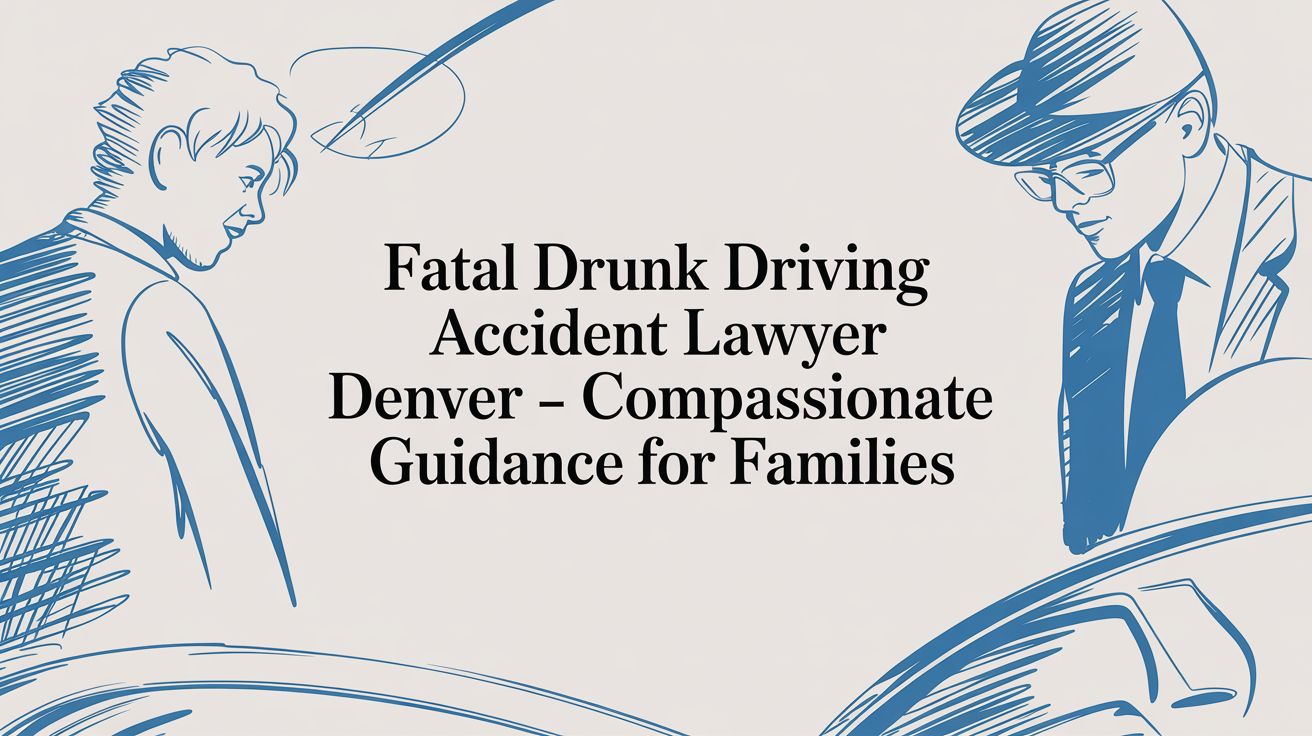Table of Contents
Missing a filing deadline is a silent killer of valid personal injury claims. Your firm could have a slam-dunk case—clear liability, significant damages, compelling evidence—but if the statute of limitations expires, that case is worth zero. For PI law firms, managing these critical dates isn't just an administrative task; it's a core operational function that protects both your client's rights and your firm's bottom line.
Many firms struggle with inconsistent, manual tracking systems. Sticky notes, calendar reminders, and spreadsheet entries create opportunities for human error, leading to missed deadlines, lost revenue, and potential malpractice claims. The challenge is clear: how do you build a system that makes missing the statute of limitations for personal injury in Colorado virtually impossible?
The solution lies in creating a robust, automated workflow that standardizes how your firm identifies, tracks, and acts on every critical date. This guide will walk you through the key deadlines in Colorado and provide a framework for building a bulletproof system to manage them.
The Challenge: Why Firms Miss Critical Deadlines

The statute of limitations for personal injury in Colorado is the legal system's non-negotiable expiration date on a claim. It exists to ensure legal action occurs while evidence is fresh and memories are reliable. For a personal injury firm, however, navigating these deadlines across a large caseload presents a significant operational challenge.
Waiting is a gamble your firm can’t afford. The law won't make an exception because you were deep in negotiations with an insurer or a paralegal simply miscalculated a date. The consequences are severe. Data from the Colorado Judicial Branch in 2022 showed that out of more than 1,200 personal injury lawsuits filed, an estimated 15% were thrown out for missing the deadline. That represents hundreds of clients who lost their only chance at justice due to a preventable process failure.
The core problem is a lack of systematized legal operations. When every case manager tracks deadlines differently, or when there's no central, automated reminder system, the risk of a case falling through the cracks skyrockets. This isn't just a client service issue; it's a direct threat to your firm's reputation and profitability. To help you get a handle on the rules that will shape your case, our Colorado personal injury laws guide offers a much deeper dive.
The statute of limitations isn't a suggestion; it's a hard stop. It provides finality for defendants and, for your clients, it creates an undeniable urgency that your firm must manage flawlessly.
To give you a quick reference for where your cases might fall, here's a simple breakdown of the most common filing deadlines.
Colorado Personal Injury Filing Deadlines at a Glance
This table provides a quick summary of the different statutes of limitations for common personal injury claims in Colorado.
| Type of Injury Claim | Statute of Limitations Deadline |
|---|---|
| General Negligence (e.g., slip and fall, dog bite) | 2 Years from the date of injury |
| Motor Vehicle Accidents (car, truck, motorcycle) | 3 Years from the date of the accident |
| Claims Against Government (e.g., city, county) | 180-day notice required, then 2-year lawsuit deadline |
| Wrongful Death | 2 Years from the date of death |
While these deadlines seem straightforward, they are far from simple. Several exceptions and special circumstances can change the timeline entirely.
The Solution: Automating Your Deadline Management System
When it comes to personal injury cases in Colorado, most people operate under a two-year deadline. But there's a huge exception carved out in the law specifically for motor vehicle accidents. If you're managing a case involving a car, truck, or motorcycle crash, the statute of limitations for personal injury in Colorado is extended to three years.
This extension recognizes that auto accident claims are a different beast. Injuries often have a delayed onset, and negotiations with insurance companies can be notoriously slow. The three-year window prevents insurers from using stall tactics to simply run out the clock on your client's right to file a lawsuit. Understanding how this works, and whether Colorado is a no-fault state, is a critical piece of the puzzle.
The sheer number of crashes in our state makes this rule essential. The Colorado Department of Transportation reported a staggering 112,345 crashes in 2021 alone, which resulted in 76,432 injuries. For a PI firm, this volume means you cannot rely on manual methods. A single mistake can be catastrophic.
The solution is to build an automated workflow that removes human error from the equation. A well-designed system will automatically calculate and calendar every critical date from the moment a new case is opened in your practice management software.
A Framework for Bulletproof Deadline Tracking
Here are three practical steps to automate deadline management at your firm:
Standardize Intake with a "Master Deadline" Field: During your initial client intake, create a mandatory field in your CRM or case management system for the "Date of Incident." This single piece of data becomes the trigger for your entire automation sequence. From this date, your system can automatically calculate the primary statute of limitations, as well as other key deadlines like the 180-day notice for government claims.
Implement Redundant, Automated Calendaring: Connect your case management software to your firm's calendars (e.g., Google Calendar, Outlook). When the "Date of Incident" is entered, the system should automatically create a series of calendar events with escalating alerts:
- 2-Year Warning: For a 3-year SOL, an alert two years out.
- 1-Year Warning: A major review milestone.
- 6-Month, 90-Day, 30-Day, and 7-Day Alerts: These should trigger notifications for the assigned attorney, paralegal, and a managing partner to ensure multiple eyes are on the approaching deadline.
Create an Automated Task Workflow: Beyond simple reminders, build a task-based workflow. For example, the 6-month alert should automatically assign a task to the paralegal to "Begin Drafting Complaint" and another to the attorney to "Schedule Pre-Filing Strategy Meeting." This turns a passive reminder into an actionable, trackable process, ensuring proactive steps are taken well before the deadline looms.
This approach transforms deadline tracking from a source of anxiety into a reliable, automated process that saves time, reduces risk, and allows your team to focus on high-value legal work.
Key Exceptions That Can Change Your Filing Deadline
The general deadlines for personal injury and auto accident claims in Colorado cover most situations, but they are far from absolute. These exceptions can dramatically alter the filing window—sometimes pausing the clock for years, other times shrinking it to just a few months.
Assuming a standard timeline applies to a case can be a catastrophic mistake for your firm. Two scenarios really drive this point home: claims involving minors and those filed against government bodies. These are polar opposites, showing just how tricky the statute of limitations for personal injury in Colorado can be and why a one-size-fits-all approach is so dangerous.
This decision tree shows a simplified path for figuring out the deadline for a Colorado car accident claim.

As you can see, the three-year rule for car accidents is a critical starting point, but it's rarely the end of the analysis.
When the Clock Is Paused for Minors
Colorado law gives special protection to children who are injured because of someone else’s negligence. When a minor (anyone under 18) gets hurt, the statute of limitations clock is “tolled”—a legal term that just means it’s paused.
The clock doesn’t start ticking until the child’s 18th birthday. This means an injury sustained in childhood doesn't expire. The victim has until their 20th birthday to file a personal injury lawsuit (the standard two-year period) or their 21st birthday if it was a car accident (the three-year period). This rule exists to make sure a child's right to seek justice isn't lost simply because they were too young to take legal action themselves.
Key Takeaway: A child injured at age five does not lose their right to sue at age seven. The law preserves their right to file a claim until they are legally an adult and can make that decision for themselves.
This extended timeline gives the injured person a fair chance to understand the long-term impact of their childhood injuries and pursue a claim once they're of legal age. It’s a vital safeguard.
The Strict 180-Day Notice for Government Claims
On the complete opposite end of the spectrum are claims against the government. If your client's injury was caused by the negligence of a city, county, or state employee—or happened on public property like a park or government building—an entirely different and much stricter set of rules applies.
Under the Colorado Governmental Immunity Act (CGIA), you must provide a formal written notice of claim to the correct government body within 180 days of the injury. Let’s be clear: this is not a lawsuit. It's a mandatory first step. If you miss that tight six-month window, you are permanently barred from filing a lawsuit later, no matter how severe the injuries are.
The stakes are incredibly high. Data from the Colorado Attorney General’s office revealed that of the 1,042 personal injury claims filed against government bodies in 2021, a shocking 42% were dismissed because victims missed this critical 180-day notice deadline. This statistic shows just how unforgiving this rule is and why you have to act immediately. You can learn more about the importance of medical records in these claims to help build a strong case right from the start.
Standard vs. Exception-Based Filing Deadlines in Colorado
| Claim Scenario | Filing Deadline | Governing Rule |
|---|---|---|
| Standard Car Accident (Adult) | 3 years from the date of the accident | C.R.S. § 13-80-101 |
| Injury to a Minor (Non-Auto) | 2 years after the minor's 18th birthday | C.R.S. § 13-80-102 & Tolling Rules |
| Claim vs. a Government Entity | 180 days to file a formal Notice of Claim | Colorado Governmental Immunity Act (CGIA) |
As you can see, the timeline can range from several years to just a few months. Navigating these exceptions requires careful legal analysis. The contrast between having years to file as a minor and mere months to act against a government entity shows why you can never assume your deadline is straightforward.
How the Discovery Rule Can Revive Your Case

The statute of limitations can feel like a brick wall. Miss the deadline, and a case is over. But what happens when your client doesn't even know they've been injured until years after the incident?
Colorado law has an answer for that exact problem. It’s called the discovery rule, and it’s a critical legal principle that can rescue a claim that would otherwise be barred by the clock. Under this rule, the statute of limitations clock doesn't start ticking on the date the negligent act happened. Instead, the timer begins on the date the injury was discovered, or—and this is key—the date it reasonably should have been discovered.
This can shift the entire timeline, opening a path to justice for people with hidden or slow-developing injuries. It's an absolutely essential concept to understand when we talk about the statute of limitations for personal injury in Colorado.
The discovery rule is built on a foundation of fairness: your client's right to seek justice shouldn't expire before they even know they've been wronged. It's a protection for those whose injuries were hidden, misdiagnosed, or took years to surface.
The discovery rule isn’t a get-out-of-jail-free card for every late claim. It only applies in specific situations where a victim truly could not have known they were hurt. You, as the legal professional, have to prove why the discovery was justifiably delayed.
Real Example: Conduit Legal's Impact
Before working with Conduit Legal, a thriving seven-figure PI firm in Denver was managing its statutes of limitation with a combination of a master spreadsheet and individual attorney calendars. The system was functional but fragile. The managing partner lived with a constant, low-level anxiety that a complex case with a non-obvious deadline—like a government claim or a tolled deadline for a minor—would be missed. The process required hours of manual cross-checking each month, pulling attorneys away from client work.
We implemented a new workflow centered on their existing case management software. By building an automation that triggered off the "Date of Incident" field entered during intake, we created a hands-off system.
The results were immediate:
- Time Saved: The firm saved approximately 15 hours per month in administrative time previously spent on manual deadline tracking and verification.
- Risk Eliminated: With redundant, automated alerts sent to attorneys, paralegals, and management, the risk of a missed deadline dropped to virtually zero. The firm’s malpractice insurance carrier even noted the new system as a positive factor in risk reduction.
- Smoother Workflows: Pre-filing tasks are now automatically assigned based on date triggers, ensuring cases progress smoothly and proactively, rather than in a last-minute rush to beat the clock.
This is the power of systems thinking. By replacing a manual, high-risk process with a simple automation, the firm not only saved time and money but also gained invaluable peace of mind.
Take Control of Your Firm's Deadlines

Managing the statute of limitations for personal injury in Colorado is a high-stakes responsibility. A single error can lead to a lost case, a malpractice suit, and damage to your firm’s reputation. Relying on manual processes in today's legal landscape is an unnecessary risk.
By implementing a standardized and automated system for deadline management, you can protect your clients, empower your team, and build a more resilient and profitable law firm. The framework is simple: standardize your intake process, implement redundant automated calendaring, and build proactive task workflows. This approach turns a major source of operational risk into a streamlined, reliable system that runs in the background, giving you and your team the confidence to focus on winning cases.
Start your free 20-minute automation audit and discover how to save hours every week without adding staff.
Written by
Conduit Law
Personal injury attorney at Conduit Law, dedicated to helping Colorado accident victims get the compensation they deserve.
Learn more about our team



